Geophysics and Geochemistry Reveal the Formation Mechanism of the Kahui Geothermal Field in Western Sichuan, China
Abstract
1. Introduction
2. Geological Overview
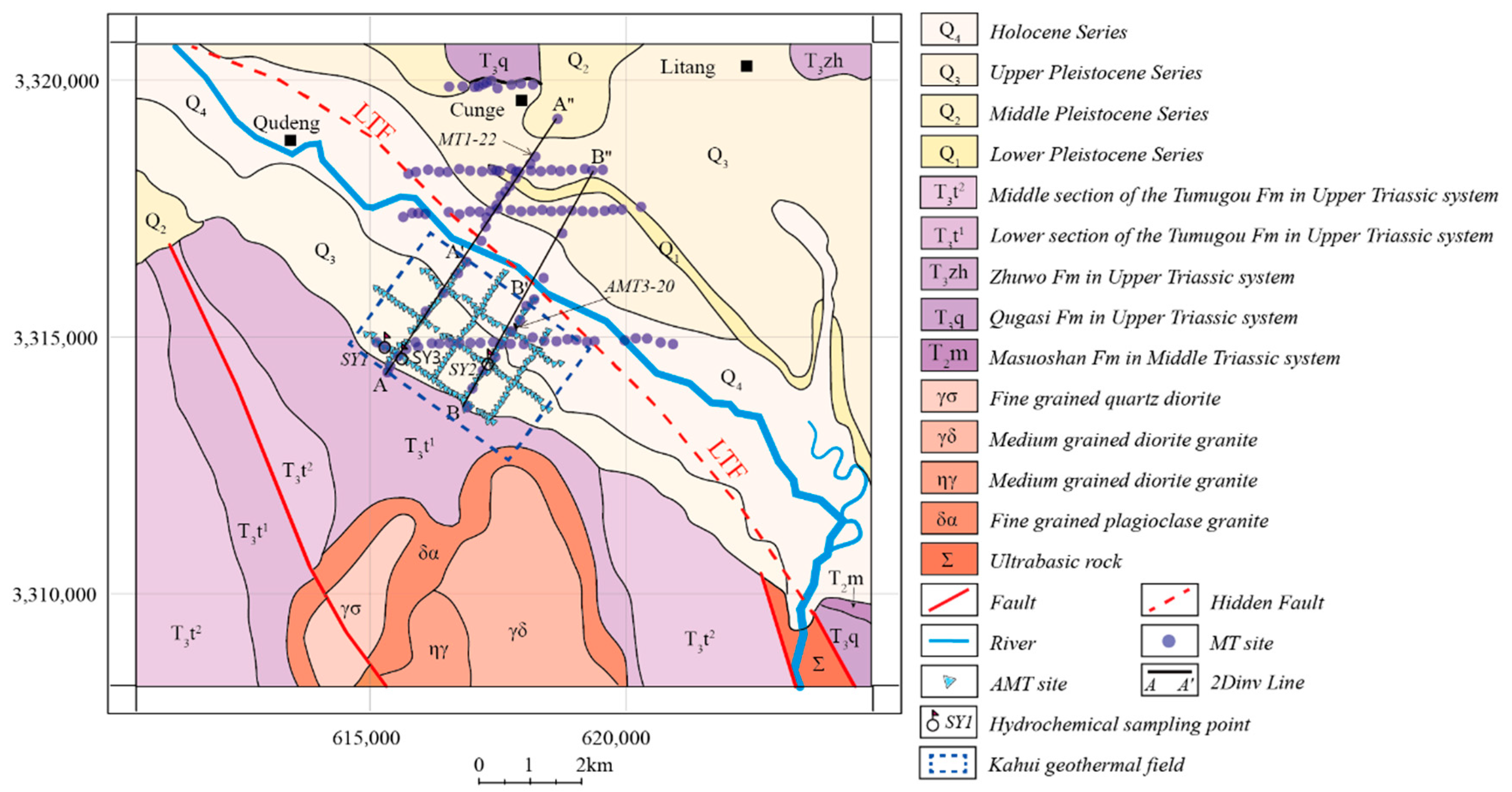
3. Data Acquisition and Processing
3.1. Geophysical Data Acquisition and Processing
3.1.1. Data Acquisition
3.1.2. Data Processing
3.1.3. 2D Inversion
3.1.4. 3D Inversion
3.2. Geochemical Data Acquisition
4. Results
4.1. Resistivity Model
4.2. Water Chemistry Type
5. Discussion
5.1. Geological Interpretation
5.2. Fluid Sources
5.3. Ion Source Analysis
5.4. Heat Source Analysis
5.5. Tectonic Control for Geothermal Formation
5.6. Formation Mechanism of the Kahui Geothermal Field
6. Conclusions
- Deep Geological Structure and Controlling Fault Identification: Geophysical inversion results revealed a three layer resistivity structure beneath the Kahui Geothermal Field, characterized by a high resistivity layer near the surface, a low resistivity layer in the middle, and a high resistivity layer at depth. This resistivity structure reflects the geological characteristics of the geothermal field. The shallow part of the Kahui Geothermal Field is controlled by the Kahui Fault. Recognizing the Kahui Fault offers new insights into the circulation pathways and discharge mechanisms of geothermal fluids in the region and provides crucial geological evidence for exploring other geothermal fields in western Sichuan.
- The Geochemical Characteristics and Recharge Sources of Geothermal Fluids: Hydrochemical analysis indicated that the fluid type in the Kahui Geothermal Field is HCO3−Na, primarily sourced from atmospheric precipitation, with secondary contributions from snowmelt and groundwater recharge. During deep circulation, interactions with rocks—particularly the dissolution of feldspar minerals and cation exchange reactions—lead to the enrichment of Na+ and HCO3−. Additionally, variations in the SO42− concentration reflected the oxidation of sulfides in the shallow oxidizing environment. These findings not only elucidate the chemical evolution of fluids in the Kahui Geothermal Field but also provide a scientific basis for understanding fluid sources in similar geothermal systems.
- Deep Heat Source and Geothermal Formation Mechanism: The deep heat source of the Kahui Geothermal Field mainly originates from the partial melting of the middle crust due to upwelling mantle fluids, which provides the high temperature heat source necessary for heating atmospheric precipitation during deep circulation. Integrating the regional tectonic context, the formation mechanism of the Kahui Geothermal Field can be summarized as follows: Atmospheric precipitation infiltrates through tectonic fractures, absorbs heat during deep circulation, and mixes with shallow cold water upon ascent, ultimately emerging as hot springs at the surface. This model not only explains the formation process of the Kahui Geothermal Field but also serves as a reference for understanding the formation mechanisms of other geothermal fields in the western Sichuan region.
Author Contributions
Funding
Data Availability Statement
Conflicts of Interest
References
- Ford, B.J. Geothermal: Our ultimate energy source. Process Eng. 2023, 10–13. [Google Scholar]
- Hassan, Q.; Viktor, P.; Al-Musawi, T.J.; Ali, B.M.; Algburi, S.; Alzoubi, H.M.; Al-Jiboory, A.K.; Sameen, A.Z.; Salman, H.M.; Jaszczur, M. The renewable energy role in the global energy Transformations. Renew. Energy Focus 2024, 48, 100545. [Google Scholar] [CrossRef]
- Teixeira, R.; Cerveira, A.; Pires, E.J.S.; Baptista, J. Advancing Renewable Energy Forecasting: A Comprehensive Review of Renewable Energy Forecasting Methods. Energies 2024, 17, 3480. [Google Scholar] [CrossRef]
- Fan, J.; Zhu, J.S.; Jiang, X.T.; Wu, P.; Yang, Y.H. Lithosphere and asthenosphere structure on eastern margin of qinghai-tibet plateau in China. China Mater. Prog. 2015, 42, 746–752. [Google Scholar] [CrossRef]
- Li, J.; Wang, X.B.; Qin, Q.Y.; Zhang, G.; Li, D.H.; Zhou, J. Deep physical structure and geotectonic implications of the eastern margin of the Qinghai–Tibet plateau. Earth Sci. Res. J. 2016, 20, A1–A8. [Google Scholar] [CrossRef]
- Hu, S.-B.; He, L.-J.; Wang, J.-Y. View Correspondence. Compilation of heat flow data in the China continental area. Acta Geophys. Sin. 2001, 44, 611–626. [Google Scholar]
- Li, J.-N.; Han, Z.-J.; Luo, J.-H.; Guo, P. Characteristics and implications of seismic activity around Minshan active block in eastern margin of Qinghai-Tibet Plateau. Seismol. Geol. 2021, 43, 1459–1484. [Google Scholar] [CrossRef]
- Rowland, J.V.; Simmons, S.F. Hydrologic, Magmatic, and Tectonic Controls on Hydrothermal Flow, Taupo Volcanic Zone, New Zealand: Implications for the Formation of Epithermal Vein Deposits. Econ. Geol. 2012, 107, 427–457. [Google Scholar] [CrossRef]
- Fridleifsson, G.O.; Elders, W.A. The Iceland Deep Drilling Project: A search for deep unconventional geothermal resources. Geothermics 2006, 34, 269–285. [Google Scholar] [CrossRef]
- Faulkner, D.; Jackson, C.; Lunn, R.; Schlische, R.; Shipton, Z.; Wibberley, C.; Withjack, M. A review of recent developments concerning the structure, mechanics and fluid flow properties of fault zones. J. Struct. Geol. 2010, 32, 1557–1575. [Google Scholar] [CrossRef]
- Wei, Y.; Hu, Y. Analysis on the formation mode of hot springs in Kahui area of Litang County. Geol. Disasters Environ. Prot. 2014, 25, 78–82. [Google Scholar]
- Shen, H.; Yang, Y.; Zhou, Z.; Rui, X.; Liao, X.; Zhao, D.; Liang, M.; Chen, M.; Guan, Z.; Ren, H. Genesis and Deep Geothermal Process of Maoya Hot Springs in Litang, Western Sichuan. Seismol. Geol. 2023, 45, 689–709. [Google Scholar]
- Chen, Y.L.; Li, D.P.; Zhou, J.; Liu, F.; Zhang, H.F.; Nie, L.S.; Jiang, L.T.; Song, B.; Liu, X.M.; Wang, Z. U-Pb dating, geochemistry, and tectonic implications of the Songpan-Ganzi block and the Longmen Shan, China. Geochem. J. 2009, 43, 77–99. [Google Scholar] [CrossRef]
- Li, S.H.; Su, T.; Spicer, R.A.; Xu, C.L.; Sherlock, S.; Halton, A.; Hoke, G.; Tian, Y.M.; Zhang, S.T.; Zhou, Z.K.; et al. Oligocene Deformation of the Chuandian Terrane in the SE Margin of the Tibetan Plateau Related to the Extrusion of Indochina. Tectonics 2020, 39, e2019TC005974. [Google Scholar] [CrossRef]
- Shao, Y.M.; Yan, D.P.; Qiu, L.; Mu, H.X.; Zhang, Y. Late Permian High-Ti and Low-Ti Basalts in the Songpan-Ganzi Terrane: Continental Breakup of the Western Margin of the South China Block. Minerals 2022, 12, 1391. [Google Scholar] [CrossRef]
- Gao, Z.J.; Sun, Y.; Huang, J.W.; Li, Q. The crustal deformation mechanism of southern Chuandian block: Constrained by S wave velocity and its azimuthal anisotropy. Geosci. Lett. 2024, 11, 40. [Google Scholar] [CrossRef]
- Gao, S.P.; Chen, L.C.; Li, Y.B.; Wang, H.; Han, M.M.; Feng, J.H.; Lu, L.L.; Peng, S.X.; Jin, C.; Liu, L.T. Rupture Behavior of the Litang Fault within the Sichuan-Yunnan Active Block, Southeastern Tibetan Plateau. Lithosphere 2021, 2021, 8773676. [Google Scholar] [CrossRef]
- Wang, S.Y.; Zhou, R.J.; Liang, M.J.; Liu, S.; Liu, N.N.; Long, J.Y. Co-Seismic Surface Rupture and Recurrence Interval of Large Earthquakes along Damaoyaba-Litang Segment of the Litang Fault on the Eastern Margin of the Tibetan Plateau in China. J. Earth Sci.-China 2021, 32, 1139–1151. [Google Scholar] [CrossRef]
- Cao, K.; Zhang, D.; Shen, X.M.; Zhang, J.F.; Wang, D.; Xu, Y.D.; Wang, G.C. Middle Miocene Onset of the Litang Fault System Records Kinematic Change in Eastern Tibet. Tectonics 2023, 42, 8773676. [Google Scholar] [CrossRef]
- Yang, Y.; Liang, M.J.; Ma, C.; Li, J.; Shen, H.L.; Du, F.; Luo, S.; Liu, S.; Rui, X.L. A palaeoearthquake event and its age revealed by the travertine layer along the Litang fault in the southeastern margin of the Qinghai-Tibetan plateau. Earthq. Res. Adv. 2023, 3, 100215. [Google Scholar]
- Yan, S.T.; Ding, A.L.; Dai, X.J.; Liu, T.; Li, H.; Dai, H.R.; Chen, P.; Wu, Q.S.; Zhu, L.D. Triassic oceanic—Continental transition of the Ganzi—Litang Ocean basin: Evidence from high-Mg andesites and Nb-enriched basalts in the Litang area, Eastern Tibet. J. Asian Earth Sci. 2024, 266, 106136. [Google Scholar] [CrossRef]
- Groom, R.W.; Bailey, R.C. Decomposition of Magnetotelluric Impedance Tensors in the Presence of Local 3-Dimensional Galvanic Distortion. J. Geophys. Res.-Solid 1989, 94, 1913–1925. [Google Scholar] [CrossRef]
- Groom, R.W.; Bailey, R.C. Analytic Investigations of the Effects of near-Surface 3-Dimensional Galvanic Scatterers on Mt Tensor Decompositions. Geophysics 1991, 56, 496–518. [Google Scholar] [CrossRef][Green Version]
- Kelbert, A.; Meqbel, N.; Egbert, G.D.; Tandon, K. ModEM: A modular system for inversion of electromagnetic geophysical data. Comput. Geosci. 2014, 66, 40–53. [Google Scholar] [CrossRef]
- Zhang, Y.H.; Yao, R.W.; Deng, C.D.; Huang, X.; Lv, G.; Li, X.; Wang, Y. Genetic mechanism of geothermal water in the sandstone reservoir of western Sichuan, SW China: Evidence from hydrochemistry and δD−δ18O isotopes. Ore Geol. Rev. 2024, 167, 105994. [Google Scholar] [CrossRef]
- Wang, H. Study on the Characteristics and Causes of High Temperature Hydrochemistry in Litang Geothermal Field in Western Sichuan. Master’s Thesis, China University of Petroleum, Beijing, China, 2020. [Google Scholar]
- Giggenbach, W.F.V.C. Geothermal solute equilibria. Derivation of Na-K-Mg-Ca geoindicators. Geochim. Cosmochim. Acta 1988, 52, 2749–2765. [Google Scholar] [CrossRef]
- Romano, P.; Liotta, M. Using and abusing Giggenbach ternary Na-K-Mg diagram. Chem. Geol. 2020, 541, 119577. [Google Scholar] [CrossRef]
- Yang, M.X.; Nelson, F.E.; Shiklomanov, N.; Guo, D.L.; Wan, G.N. Permafrost degradation and its environmental effects on the Tibetan Plateau: A review of recent research. Earth-Sci. Rev. 2010, 103, 31–44. [Google Scholar] [CrossRef]
- Yang, Y.; Hopping, K.; Wang, G.; Chen, J.; Peng, A.; Klein, J. Permafrost and drought regulate vulnerability of Tibetan Plateau grasslands to warming. Ecosphere 2018, 9, e02233. [Google Scholar] [CrossRef]
- Wang, X.J.; Ran, Y.H.; Pang, G.J.; Chen, D.L.; Su, B.; Chen, R.; Li, X.; Chen, H.W.; Yang, M.X.; Gou, X.H.; et al. Contrasting characteristics, changes, and linkages of permafrost between the Arctic and the Third Pole. Earth-Sci. Rev. 2022, 230, 104042. [Google Scholar] [CrossRef]
- Xu, X.W.; Wen, X.Z.; Yu, G.H.; Zheng, R.Z.; Luo, H.Y.; Zheng, B. Average slip rate, earthquake rupturing segmentation and recurrence behavior on the Litang fault zone, western Sichuan Province, China. Sci. China Ser. D 2005, 48, 1183–1196. [Google Scholar] [CrossRef]
- Zhang, C.Q.; Wu, Z.H.; Zhou, C.J.; Tian, T.T.; Li, Y.H.; lI, J.B. Paleoearthquake events and inhomogeneous activity characteristics in the Benge-Cunge section of the Litang fault zone in the western Sichuan Province. Acta Geol. Sin. 2020, 94, 1295–1303. [Google Scholar]
- Zhang, X.B.; Yang, Z.; Zhong, N.; Yu, H.; Guo, C.B.; Yang, G.F.; Li, H.B. Late Quaternary activity and paleoearthquake recurrence characteristics of the Litang fault in western Sichuan. Acta Geol. Sin. 2023, 98, 2084–2100. [Google Scholar]
- Zhao, J.Y.; Wang, G.L.; Zhang, C.Y.; Xing, L.X.; Li, M.; Zhang, W. Genesis of Geothermal Fluid in Typical Geothermal Fields in Western Sichuan, China. Acta Geol. Sin.-Engl. 2021, 95, 873–882. [Google Scholar] [CrossRef]
- Bai, D.H.; Unsworth, M.J.; Meju, M.A.; Ma, X.B.; Teng, J.W.; Kong, X.R.; Sun, Y.; Sun, J.; Wang, L.F.; Jiang, C.S.; et al. Crustal deformation of the eastern Tibetan plateau revealed by magnetotelluric imaging. Nat. Geosci. 2010, 3, 358–362. [Google Scholar] [CrossRef]
- Li, X.F.; Li, H.Y.; Shen, Y.; Gong, M.; Shi, D.N.; Sandvol, E.; Li, A.B. Crustal Velocity Structure of the Northeastern Tibetan Plateau from Ambient Noise Surface-Wave Tomography and Its Tectonic Implications. Bull. Seism. Soc. Am. 2014, 104, 1045–1055. [Google Scholar] [CrossRef][Green Version]
- Peiffer, L.; Inguaggiato, C.; Wurl, J.; Fletcher, J.M.; Martinez, M.G.Q.; Martinez, D.C.; Legrand, D.; Morales, P.H.; Reinoza, C.E.; Tchamabe, B.C.; et al. Geochemistry of coastal geothermal systems from southern Baja California peninsula (Mexico): Fluid origins, water-rock interaction and tectonics. Chem. Geol. 2024, 670, 122316. [Google Scholar] [CrossRef]
- Li, Y.L.; Wang, C.S.; Dai, J.G.; Xu, G.Q.; Hou, Y.L.; Li, X.H. Propagation of the deformation and growth of the Tibetan–Himalayan orogen: A review. Earth-Sci. Rev. 2015, 143, 36–61. [Google Scholar] [CrossRef]
- Zhang, J.; Li, W.; Tang, X.; Tian, J.; Wang, Y.; Guo, Q.; Pang, Z. Geothermal Analysis of High-Temperature Hydrothermal Activity Area in Western Sichuan. Sci. China Earth Sci. 2017, 47, 899–915. [Google Scholar]
- Enkin, R.J.; Yang, Z.Y.; Chen, Y.; Courtillot, V.E. Paleomagnetic Constraints on the Geodynamic History of the Major Blocks of China From the Permian to the Present. J. Geophys. Res. Part B Solid Earth 1992, 97, 13953–13989. [Google Scholar] [CrossRef]
- Zhong, S.L.; Wu, J.P.; Fang, L.H.; Wang, W.L.; Fan, L.P.; Wang, H.F. Surface wave Eikonal tomography in and around the northeastern margin of the Tibetan plateau. Chin. J. Geophys. 2017, 60, 2304–2314. [Google Scholar] [CrossRef]
- Kang, J.; Han, J.; Gao, R.; Liu, L.; Xin, Z.; Meng, F.; Guo, Z.; Wang, T. Electrical Response of a Reactivated Ancient Suture Revealed by Three-Dimensional Magnetotelluric Inversion Across the Jinsha River Suture, Northern Tibetan Plateau. J. Geophys. Res. Solid Earth 2023, 128, e2022JB026264. [Google Scholar] [CrossRef]
- Wang, K.M.; Lu, L.Y.; Maupin, V.; Ding, Z.F.; Zheng, C.; Zhong, S.J. Surface Wave Tomography of Northeastern Tibetan Plateau Using Beamforming of Seismic Noise at a Dense Array. J. Geophys. Res. Solid Earth 2020, 125, e2019JB018416. [Google Scholar] [CrossRef]
- Yu, N.; Unsworth, M.; Wang, X.B.; Li, D.W.; Wang, E.C.; Li, R.H.; Hu, Y.B.; Cai, X.L. New Insights Into Crustal and Mantle Flow Beneath the Red River Fault Zone and Adjacent Areas on the Southern Margin of the Tibetan Plateau Revealed by a 3-D Magnetotelluric Study. J. Geophys. Res. Solid Earth 2020, 125, e2020JB019396. [Google Scholar] [CrossRef]

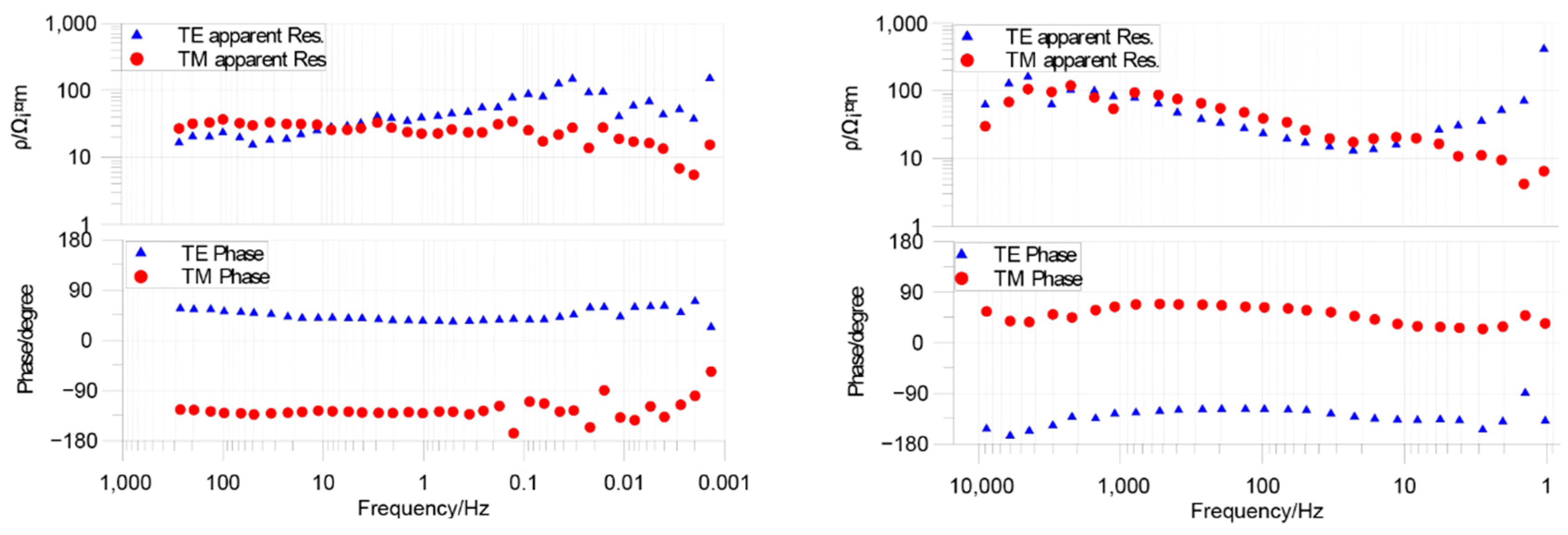
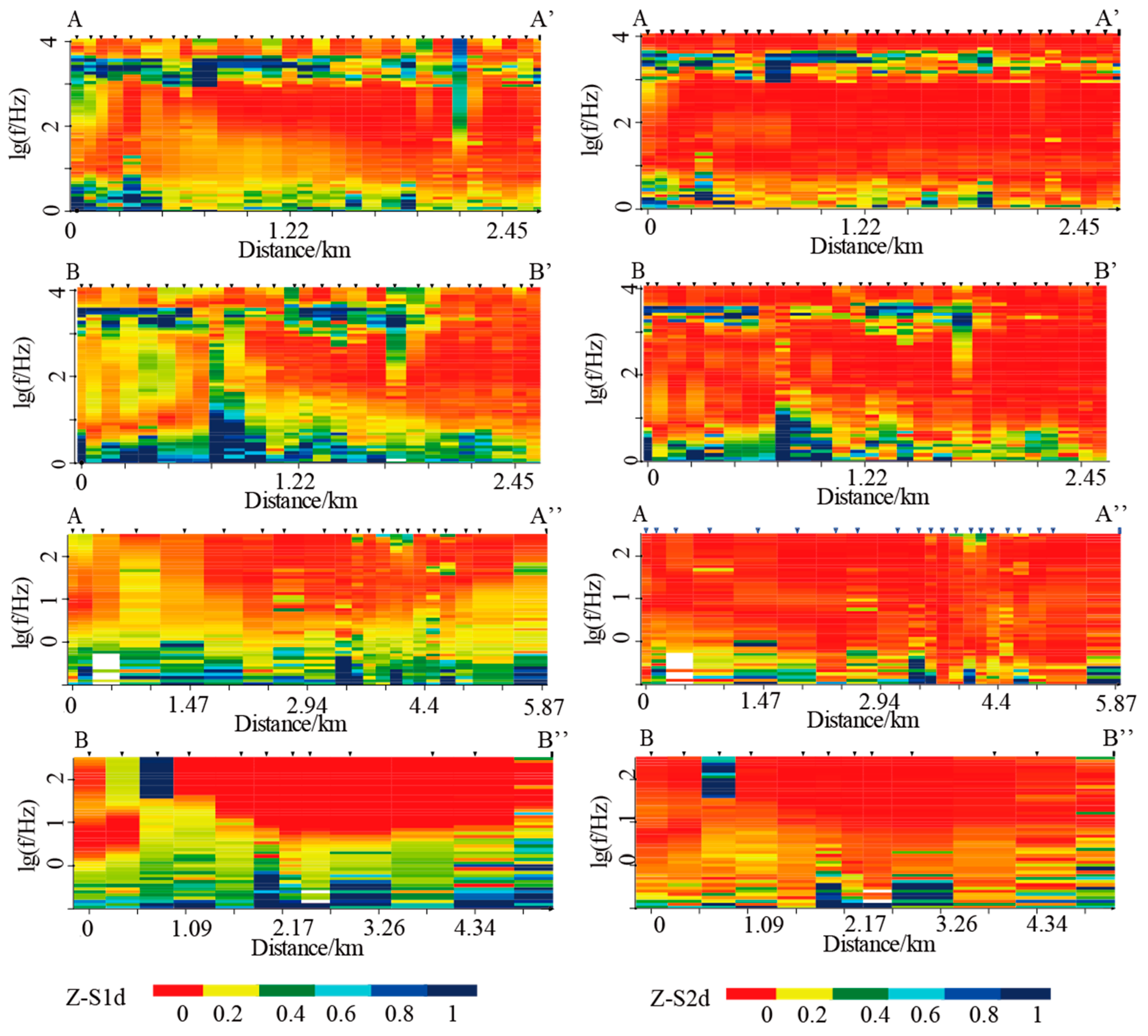
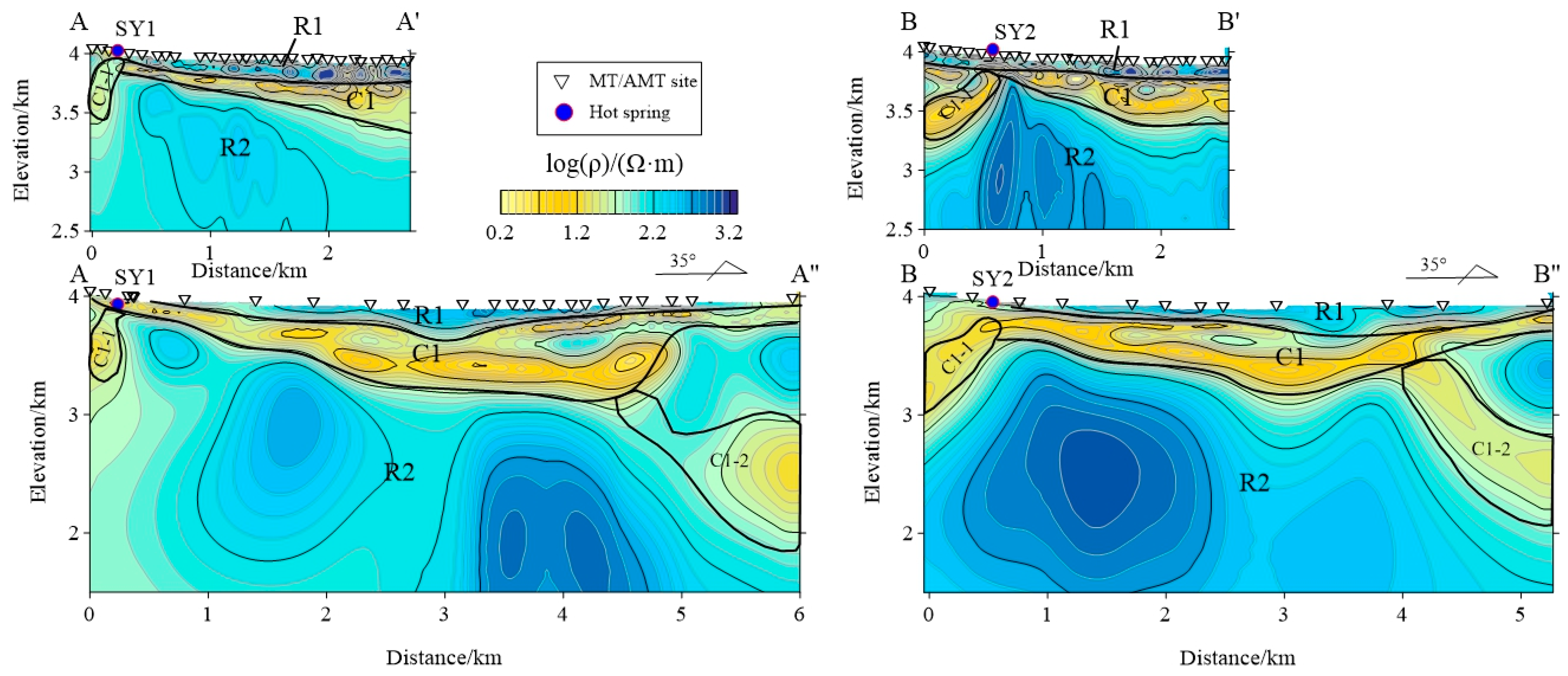



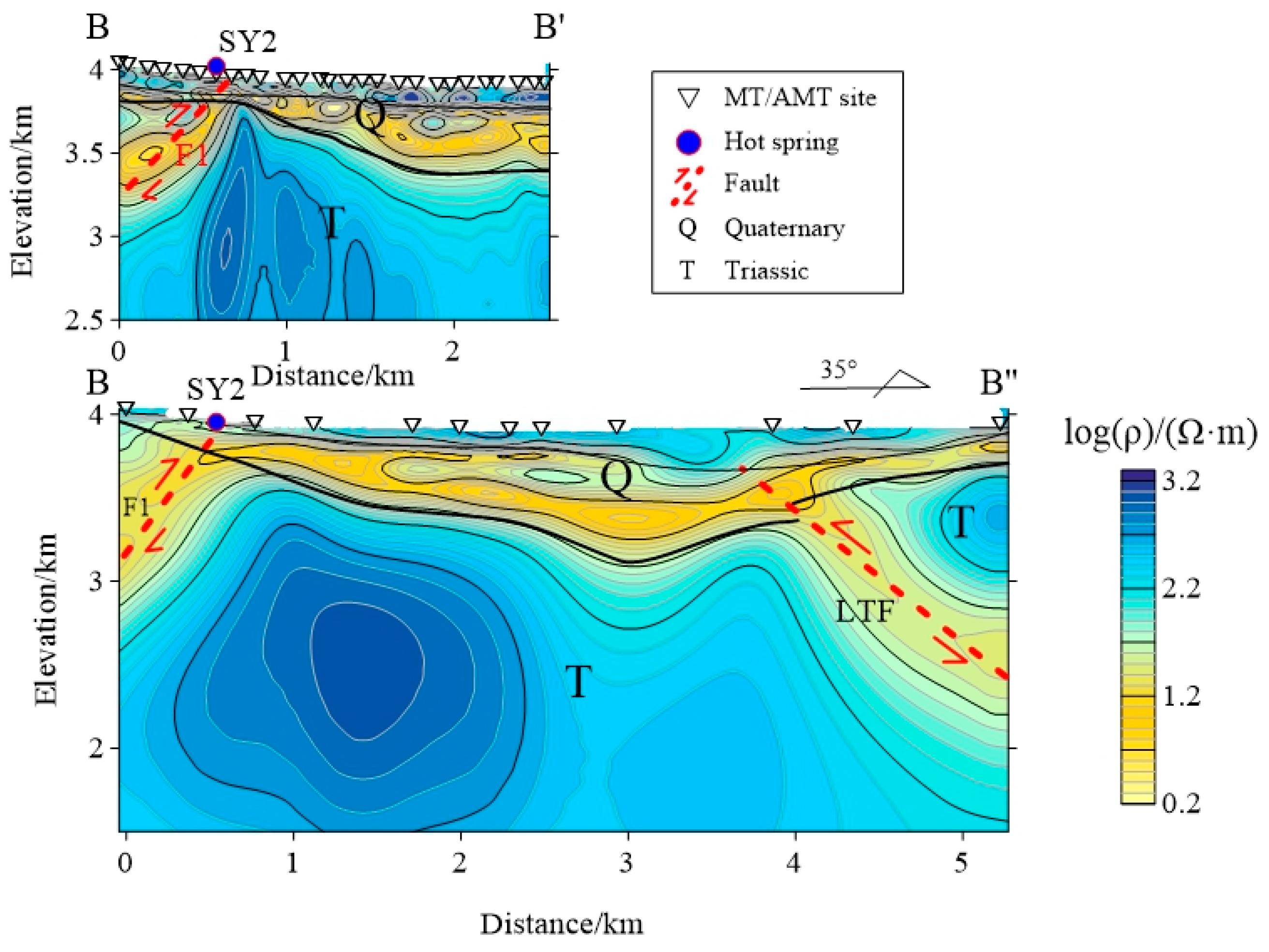
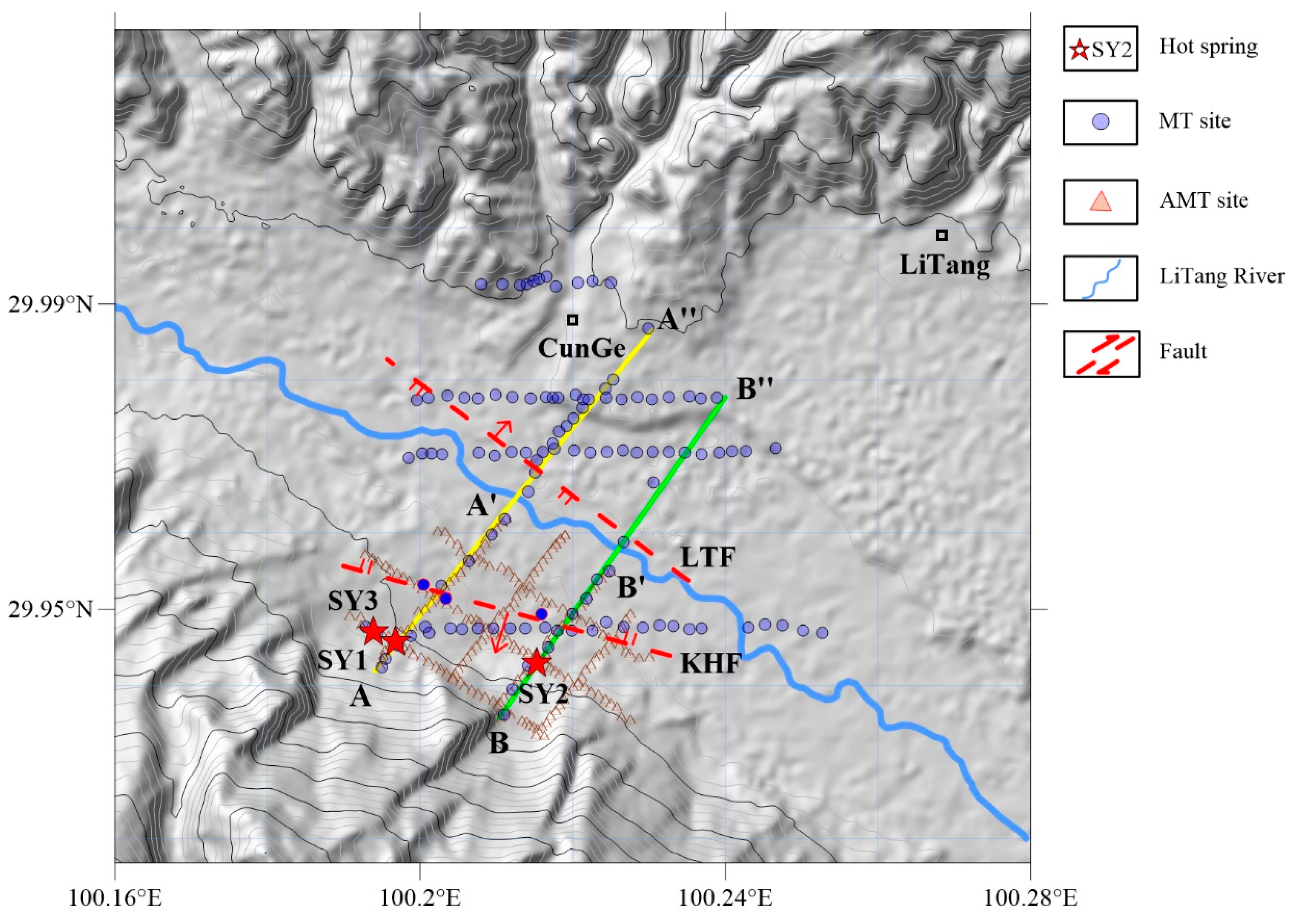

| Sample | Lon. (E) | Lat. (N) | pH | Temp/°C | TDS | K+ | Na+ | Ca2+ | Mg2+ | Cl− | SO42− | HCO3− | CO3− | NO3− | F− | Sulfide (Calculated as S2−) | Radon (Bq/L) | SiO2 | δD(‰) | δ18O (‰) | Hydrochemical Type | |
|---|---|---|---|---|---|---|---|---|---|---|---|---|---|---|---|---|---|---|---|---|---|---|
| SY1 | 100.1968 | 29.9457 | 8.34 | 77 | 190 | 2.51 | 62.2 | 3.88 | 0.065 | 7.1 | 11.9 | 145.8 | 2.4 | 0.04 | 2.45 | 7.31 | 3.94 | — | HCO3-Na | |||
| SY2 | 100.2153 | 29.9429 | 8.67 | 82 | 342 | 2.92 | 72.1 | 3.31 | 0.027 | 3.5 | 16.6 | 148.3 | 9 | 0.04 | 2.85 | 2.42 | 1.23 | |||||
| SY3 | 100.1938 | 29.9470 | 8.56 | 58 | 150 | 1.78 | 50.6 | 3.75 | 0.061 | 3.5 | 8.66 | 110.4 | 6.6 | 1 | 1.86 | 4.03 | 0.822 | |||||
| LT-7 [12] | — | 8.5 | 79.6 | 168 | 1.6 | 57.2 | 4.1 | 0.0 | 7.6 | 20.5 | 158.6 | — | 0.1 | — | 59.5 | −161.9 | −21.4 | HCO3-Na | ||||
| S1 | 100.1487 | 29.6321 | 8.6 | 78 | 394.5 | 2.85 | 86.32 | 7.64 | 0.20 | 0.91 | 48.21 | 165.87 | — | 2.01 | — | −157.5 | −20.32 | HCO3·SO4-Na | ||||
| S2 | 100.1349 | 29.6335 | 8.4 | 76 | 354.1 | 3.02 | 70.65 | 5.03 | 0.17 | 0.70 | 47.67 | 135.82 | 3.02 | −157.0 | −20.26 | |||||||
| S3 | 100.1354 | 29.6348 | 8.5 | 77 | 351.8 | 2.03 | 69.54 | 3.82 | 0.15 | 1.53 | 48.12 | 119.21 | 2.54 | −156.8 | −20.67 | |||||||
| S4 [25] | 100.1607 | 29.9649 | 8.5 | 55 | 254.1 | 1.83 | 51.88 | 6.02 | 0.21 | 0.63 | 23.41 | 132.50 | 2.41 | −156.9 | −20.61 | HCO3-Na | ||||||
| Six samples [26] | min | — | 0.65 | 5.48 | 2.78 | — | 1.75 | 2.82 | 30.51 | — | 1.20 | — | −163 | −21.5 | HCO3-Na | |||||||
| max | 2.80 | 72.32 | 4.32 | — | 7.00 | 16.66 | 161.7 | — | 1.27 | −159 | −21.2 | |||||||||||
| average | 2.21 | 55.41 | 3.71 | — | 2.63 | 13.52 | 127.6 | — | 1.23 | −161.8 | −21.38 | |||||||||||
| Q01 | — | 8.7–8.8 | 72–74 | — | 112.6 | — | HCO3-Na | |||||||||||||||
| Q02 | 8.5 | 83 | 110.5 | |||||||||||||||||||
| Q03 | 8.5 | 78 | 96.93 | |||||||||||||||||||
| Q04 [11] | 8.2 | 55 | 58.12 | HCO3·SO4-Na | ||||||||||||||||||
Disclaimer/Publisher’s Note: The statements, opinions and data contained in all publications are solely those of the individual author(s) and contributor(s) and not of MDPI and/or the editor(s). MDPI and/or the editor(s) disclaim responsibility for any injury to people or property resulting from any ideas, methods, instructions or products referred to in the content. |
© 2025 by the authors. Licensee MDPI, Basel, Switzerland. This article is an open access article distributed under the terms and conditions of the Creative Commons Attribution (CC BY) license (https://creativecommons.org/licenses/by/4.0/).
Share and Cite
Liu, Z.; Ye, G.; Wang, H.; Dong, H.; Xu, B.; Zhu, H. Geophysics and Geochemistry Reveal the Formation Mechanism of the Kahui Geothermal Field in Western Sichuan, China. Minerals 2025, 15, 339. https://doi.org/10.3390/min15040339
Liu Z, Ye G, Wang H, Dong H, Xu B, Zhu H. Geophysics and Geochemistry Reveal the Formation Mechanism of the Kahui Geothermal Field in Western Sichuan, China. Minerals. 2025; 15(4):339. https://doi.org/10.3390/min15040339
Chicago/Turabian StyleLiu, Zhilong, Gaofeng Ye, Huan Wang, Hao Dong, Bowen Xu, and Huailiang Zhu. 2025. "Geophysics and Geochemistry Reveal the Formation Mechanism of the Kahui Geothermal Field in Western Sichuan, China" Minerals 15, no. 4: 339. https://doi.org/10.3390/min15040339
APA StyleLiu, Z., Ye, G., Wang, H., Dong, H., Xu, B., & Zhu, H. (2025). Geophysics and Geochemistry Reveal the Formation Mechanism of the Kahui Geothermal Field in Western Sichuan, China. Minerals, 15(4), 339. https://doi.org/10.3390/min15040339






